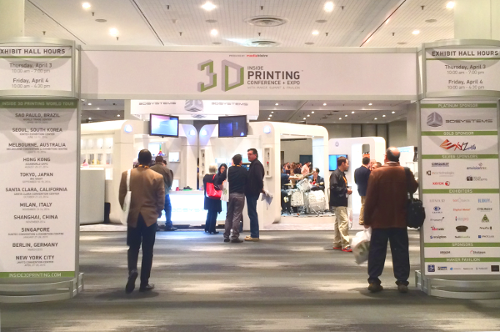Explaining to family and friends that you are taking a train to see a bunch of weird microwave-looking machines print 3-dimensional objects out of what seems like thin air, is a bit like telling them your hopping on a train to Hogwart’s. At least—from the looks on the faces I saw—I imagine the reactions must be similar. Alas, while there were no wizards (as far as I could tell) present at the Inside 3D Printing Conference + Expo earlier this month, that’s not to say that the event was any less magical.
With a live jazz band, a buzzing exhibit hall, and the low hiss and hum from the plethora of 3D printing machines—each with their own flare and personality—there was much and more to keep any tech consumer’s eyes open wider than a kid’s on Christmas. Turn left and see model cities printed straight from a machine, turn right and find a scale Ford Grand Torino composed entirely from liquid metal shaped from a 3D-printer. Walk a bit further and find a row of 3D makers—each with their creations hot off the presses—proudly displaying their latest . . . innovation? Tech? Art? They all had one thing in common: they were all pioneering the future.
And just in case you get all curmudgeonly about 3D printing, in fact, being the future, there was a panel of distinguished industry speakers all ready to prove to you wrong.
Perhaps the most telling—and least publicized— implicating of the future-altering potential of 3D printing is the way it has already begun to disrupt companies on the industrial side of things. The orange and blue plastic toy products that try and market consumer-grade printers are nifty and cool and are sure to impress your friends at a dinner party, but the real magic is happening in industry.
Cheaper, Faster, More Flexible
Every ingredient that goes into manufacturing a thing, regardless of what that thing is, has a history that can be mitigated by the introduction of 3D printing or “additive manufacturing.” Why waste time and money on the procuring, shipping and assembly of a part or material when you can just print it on-site? These were the questions Curtis Carson, Head of Systems Integration with Airbus, raised during his keynote speech on the vision Airbus has for the future applications of 3D printing.
“We see potential to save money . . . to produce with more flexibility,” said Carson, raising what in the industry is known as “buy to fly,” the ratio of materials bought to manufacture an aircraft, versus the percentage that actually ends up flying in the finished product. Additive manufacturing inherently slims down waste, improving this ratio. When you print only that which you need, there is little to no excess waste. What you need is what you print. What you print is what you use. Simple.
“Optimization is key,” says Carson, pointing to the staggering four million individual components and 361 metric tons that make up the company’s largest aircraft. “These kilos cost money.” By incorporating 3D printing technologies into the manufacturing process, Airbus has been able to save €80K on producing lighter cabin brackets—not including all the savings on the other components replaced by printed counterparts.
Said Carson, “Weight is performance . . . is less fuel burn . . . maybe we can fly farther. This is the flexibility our industry needs.” Flexibility means saved money. Flexibility means greater innovation. Who knows —maybe it even means you can finally pack all those extra argyle-patterned dress socks and not have to pay a luggage fee. That’s the point: the technology is opening up new possibilities to business and consumers. That’s exciting . . . (especially if you like argyle).
Of course, while the implications of using additive manufacturing paves the way for unprecedented advancements, and while 3D printing isn’t exactly “new,” don’t expect the second industrial revolution to happen tomorrow. Think of the technology as still being in its adolescence: growing, finding out new things about itself, and still a bit awkward.
As Carson was stern to remind us, “it’s not flipping the switch; the potential that’s there has to be unlocked.”
The great thing about attending events like the Inside 3D Printing Conference + Expo is that you get to see all the different ways people start to do the unlocking.
I assure you, it’s nothing short of wizardry.





